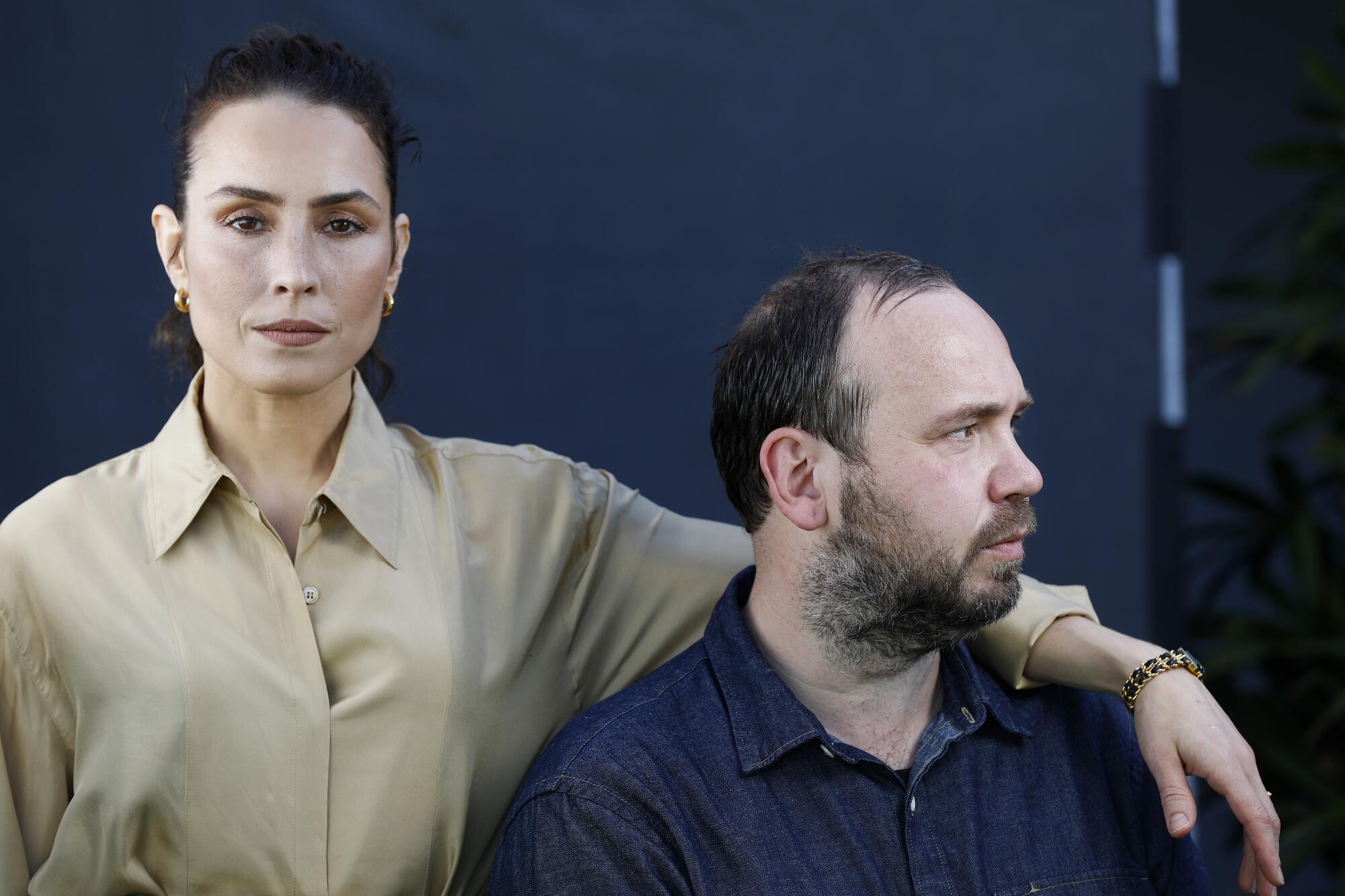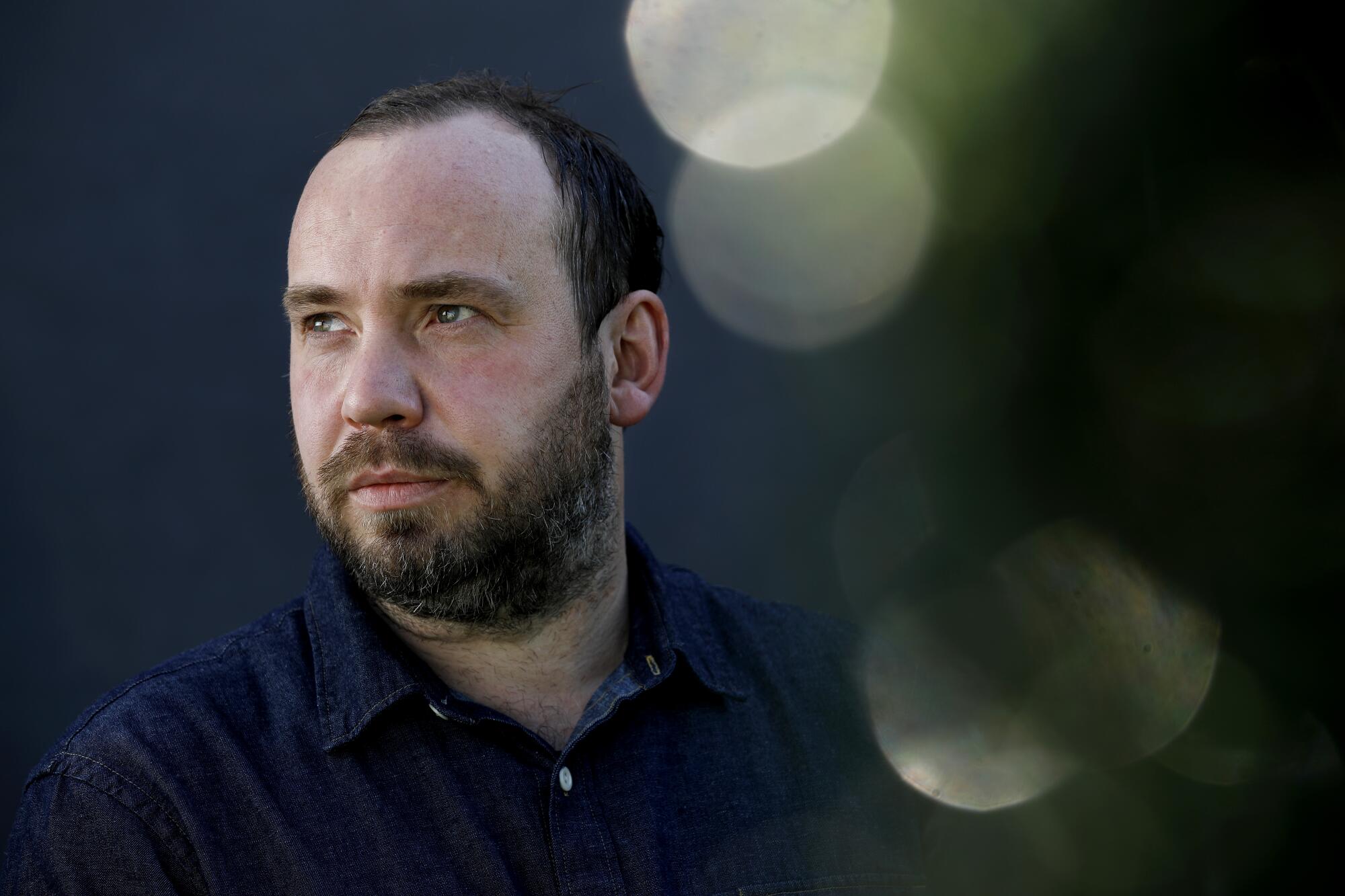
- Share via
Warning: This story contains spoilers about A24’s “Lamb.” There will be another warning before key plot points and details about the ending are divulged.
In northern Iceland, a couple struggles to move on from a devastating loss. While the birth of a mysterious creature on their remote farm seems to afford them a second chance at parenting, dark forces threaten to reclaim the source of their newfound joy.
That’s the premise behind A24’s “Lamb,” director Valdimar Jóhannsson’s feature debut from a script he co-wrote with the Icelandic poet Sjón, which stars Noomi Rapace and Hilmir Snær Guðnason.
Now playing in theaters nationwide, the film snagged the prize of originality at this year’s Cannes Film Festival. Its story, which blends regional Icelandic folklore with Jóhannsson’s own peculiar imaginings, was partially inspired by the director’s childhood spent with his grandparents on their sheep farm. “I’m very fascinated with sheep and lambs,” he said. “We decided from the beginning that it should be about sheep farmers. We also had the creatures in mind when me and Sjón started working together in 2009.”
Noomi Rapace brings a steady but feminine power to the dark Icelandic tale “Lamb,” about a couple raising a sheep as if it were their child.
It took eight years to produce a finalized version of the story because “we were not in a hurry,” said Jóhannsson. “We just decided to take time to [develop] a solid script. We didn’t start writing [for five years], just talking about scenes and acting out things.”
Signing on was a quick yes for Rapace, who is Swedish but grew up in Iceland and rose to fame there. “I felt like I’ve been waiting for this film my whole life,” she said. “I’ve been waiting for the opportunity to come back to Iceland to reconnect with that side of myself and this movie felt like layers and layers just peeled off [of me] and I had nowhere to hide or escape.
“It was so honest, this process. All these elements came together to make it a dream project.”
The Times caught up with Jóhannsson and Rapace to answer some of the lingering questions you might have after watching “Lamb.”
Warning: Spoilers about key plot points of “Lamb” follow.
What inspired the story? Where did the idea for the lamb-human hybrid, Ada, come from?
Before he’d conceived of the script, Jóhannsson began drawing images of lamb-human hybrid creatures in a visual book he later shared with Rapace. “[Sjón and I] had a lot of paintings and photos that we basically created the story around somehow,” he said.
“A lot of the directors that I’ve worked with would start with a psychological or emotional perspective,” said Rapace. “[He] starts with a visual. So he collected images that he linked together and they created the story, basically.”
Jóhannsson brought the book, the script and a book of poems by Sjón to Rapace’s house in London when he pitched her the film. “I’m sitting there with this strange mood board book and I got lost in it,” she said. “Ada was in there looking very much like she does in the movie. There were beautiful landscape pictures and then quite dark and disturbing pictures. I could feel him just reel me into his universe and I was like ‘Holy f—, I think I need to do this film.’”
As for the origin of Ada, Jóhannsson says he’s not sure. Rapace thinks a clue can be found in an old dream diary of Jóhannsson’s that his mother brought to the Icelandic premiere. “There was a dream [he] wrote down when he was quite young with rams and the big horns and all of that,” she said. “So maybe the creature, without you knowing, is from one of your early dreams.”
“Yeah, it could be,” said Jóhannsson. “People are always asking me where it started and I have no idea.”

How much did Ada’s look change over the course of production?
“I remember at first we planned to have more of Ada,” said Jóhannsson. “She was talking and doing so many [more] things but we knew that it was not a film about Ada. So in the end we took so much out and it somehow made her stronger and was much better for the story.”
“She’s very much a vehicle and a canvas,” Rapace explained. “She’s the blank space you fill with what you need her to be. She’s a perfect balance where it’s enough for people to connect with her but she doesn’t have too much of her own personality.”
“Yeah, you as an audience [member] have to create her by yourself,” said Jóhannsson. “Some people think she’s evil in the beginning or think she’s planning to do something, but other people just love her right away when they see her and think she’s very cute.”

How many of the film’s threads originated in regional myths and lore?
While Sjón is a specialist in Icelandic folktales and mythical stories, nothing about the creatures originated in folklore.
“It was more about the Christmas theme,” said Rapace, who moved to Iceland when she was around 5 years old. “Everyone was like, ‘You have to be a nice girl and behave otherwise Grýla, who is this horrific Icelandic witch, will take you and eat you,’” she said. “Or one of her 13 sons, [the Yule Lads], which are the Santa Clauses in Iceland who are all evil and really mean, will come and snatch you or do bad things to you. Or, we have a Christmas cat that’ll come and eat you. It’s strange how Christmas has a lot of these kind of dark forces surrounding the event.”
“Religious [myths] and folk tales, they are so related,” said Jóhannsson.
What was it like working with all those animals?
“It was strange at first,” said Rapace. “I was like, ‘Oh God, how’s this gonna work?’ I’ve worked with animals before, I’ve worked with kids before, but not in the same movie. I was like, ‘This is everything I don’t prefer.’ But strangely enough we got into this rhythm where I felt like I was part of something bigger. You just surrender into a different, nonverbal rhythm.”
There’s a scene where Rapace sits outside in the grass with a lamb and adorns her with a flower crown. “We’re sitting really close, face-to-face, and she all of a sudden becomes super still,” the actor remembered. “And she starts breathing [in tandem] with me. And I had this [sensation] where I felt like I knew what she was thinking. She was looking at me and moving with me — I was breathing out and she was breathing [in] my air. It was this magical moment and he didn’t say ‘Cut!’”
“It was amazing so I just wanted to keep on [going],” said Jóhannsson.
“It humbles you because we’re so convinced that the social media and technology is our reality but if you really go to the core of yourself, we’re animals too,” said Rapace. “And the primal side of me, the animal instincts came out and I felt like I spoke less and less [and began to pick up nonverbal cues more and more].”
But not every scene she shared with an animal was as idyllic. “The cat was the worst,” she said. “He was like the diva on set. Never did what we wanted.”
In one scene, the cat is meant to jump up on the bed and interact with a sleeping María. “The cat caretaker is throwing cat candy on me so I’m there [flinching every time it lands], trying to pretend that the candy is not hitting me. And the cat is sitting next to the camera just [watching]. And then it’s like ‘Cut, cut, cut.’ And then the cat jumps up and eats the candy.”
Warning: Major spoilers about the ending of “Lamb” follow.
What should we take away from the ending?
“I think everyone should decide for themselves,” said Jóhannsson.
“It was interesting, when we shot that ending we didn’t really decide what was going to happen,” said Rapace. “I came running up that hill ... and then we did various shots and takes. For me, I think it’s that life is beautiful somehow. Our willpower and our determination to stand up again and to keep on going is so strong and I think that for me in a strange way there’s hope in the ending. A painful hope.”
Where does Ada’s father take her and what is he?
“I don’t know where they live, but he can stand for so many things,” said Jóhannsson.
“Is he nature?” said Rapace. “Or the devil? Or karma? I mean, the [human characters] do take something that is not theirs to have. [Ada] doesn’t belong to them. We basically steal her and I shoot her mom! I think María knows that that happiness is a short chapter, that it’s borrowed time. That’s why she didn’t run after [Ada] — she knew that she had it coming somehow.”

What happens after the movie ends?
“I think a new chapter starts in her life,” said Rapace. “When Ada is gone and Ingvar dies in her arms, María still can find [the grit to know that] life will go on. There’s a decision to survive and to live.”
“We got a pitch the other day like, ‘What happens in “Lamb 2: María Goes to Ram Land?”’” she added with a laugh. “Who knows? I think the beauty of us humans is we have the amazing ability to heal. But you can only start the mending and healing process if you allow yourself to feel the pain. And I think in the beginning of the film her life’s on hold, she’s blocked. And by the end she’s wide open. So it will be the beginning of something new.”
More to Read
Only good movies
Get the Indie Focus newsletter, Mark Olsen's weekly guide to the world of cinema.
You may occasionally receive promotional content from the Los Angeles Times.











